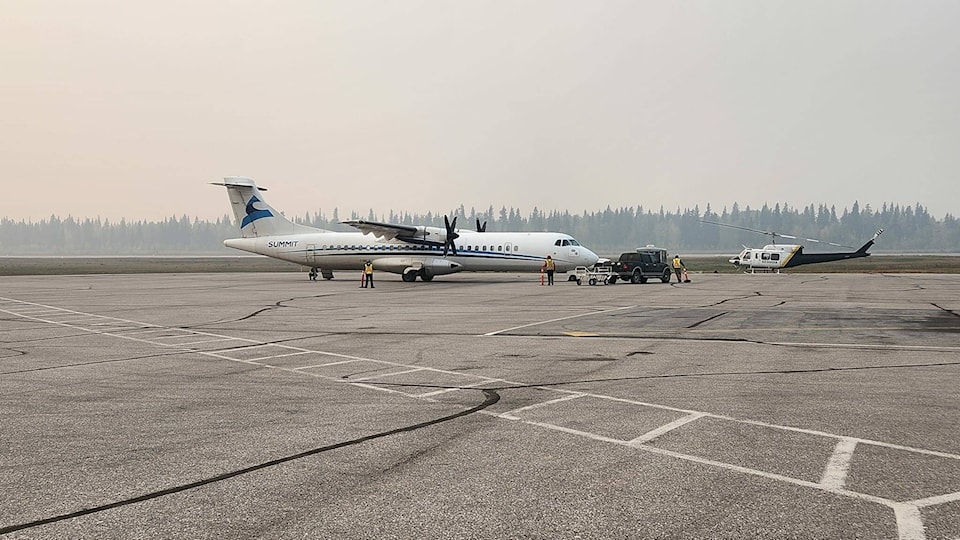Residents of Hay River have been away from their homes for more than a month, but they are now finally getting to go home.
Those who were evacuated from the town were allowed to begin returning on Sept. 16 at 9 a.m. The announcement was made on the town’s social media feed the evening prior.
“Hay River Council is pleased to announce, after review of the fire control efforts and the establishment of essential services, that the Town of Hay River will execute Phase 2 – General Public reentry of the Hay River Community Reentry Plan starting Saturday, September 16, 2023 starting at 9:00 a.m.,” read the announcement.
The exceptions to that were Paradise Gardens, Patterson Road, 2 Seasons and Castaway; the town indicated that those areas were classified as “compromised zones” and were only open to essential services and those who lived there.
Hay River’s evacuation order has been downgraded to an evacuation notice, meaning that residents should be ready to evacuate again should there be a need to.
“Returning evacuees are tired, but so happy to be back,” said Hay River Mayor Kandis Jameson during a press conference on Monday. “(Town) council recognizes that it’s been a difficult period for many and that it will take time to recover from the effects of the fire and the evacuation itself.”
She also said the re-entry so far has been quite impressive.
“People are just relieved,” she said. “Our community is still here, especially when you look at a map when you’re far away and you’re trying to find out what’s happening. I know it can be stressful, but people are just relieved and glad to be home.”
There has been significant damage in the Paradise Gardens and Patterson Road areas and Jameson said even though it’s early days yet, she plans to do whatever needs to be done to help those who lost property, whether residential or commercial.
“We have talked to many of these (residents), personally myself, as well as (senior administrative officer Glenn) Smith (and) we will be meeting with them in the coming days to see what they need from us,” she said. “A lot of them had insurance, so that is going to make a big difference, but if we can help support them … whatever we can do to support these people, we plan on doing it.”
Jameson also spoke about the effect the evacuation has had on businesses in the town and she said she plans on lobbying for every bit of support available from any level of government to get them the help they need.
“These businesses have supported our community groups, local sports teams, and residents for decades,” she said. “Many, now having been impacted by two evacuations this summer, need our support to bounce back. Five weeks of disruption is well beyond the intent of the financial support programs announced to date.”
One of the programs is the Support for Entrepreneurs and Economic Development (SEED), which is intended to provide short-term support with grants of $5,000, along with the Wildfire Assistance and Relief Measures (WARM) from BDIC NWT. That’s also worth up to $5,000 for a business located in an evacuated community.
Smith added that in prior years, the town has applied for funding through CanNor – he specifically mentioned that after the floods in 2022, the town received approximately $1.5 million in what he said was resiliency funding to help rebuild.
All of the work done to protect the town has created a massive fire break that Jameson says will protect the town for years to come.
But there is now the worry about what all that work will do when it comes to next year and the threat of flooding returns.
Smith said the 10-year capital plan approved by town council in 2021 contained measures that would make the town more flood-resistant.
“Some of it ranges from policy, such as upgrading building standards, to more significant infrastructure projects, such as some berm work in the West Point First Nation area: extensions of berms, redevelopment of berms and helping to control some of the erosion that’s been occurring in that area.”
Smith also said lifting roads around Cranberry Crescent, enhancing storm systems and backflow prevention devices are other ways the town is trying to take away the risk.
Smith cautioned that the fire is still burning and it probably won’t be totally extinguished until the snow falls.
He said there is still a lot of uncertainty and it will continue to be monitored.
“The chances of evacuation, especially a full community evacuation, is quite low,” he said. “We still have firefighters in the community, both structural and wildland firefighters, and we’ll continue to monitor and meet and enure that uncertainties come our way that can’t be managed.”
-with files from Eric Bowling and James McCarthy
